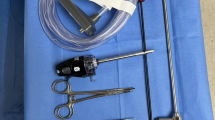Abstract
Background
Laparoscopic inguinal hernia repair is becoming more common in many countries, but the quality of care, experience of the operating surgeon, and details of the surgical technique are not known in detail on a national level in Denmark. In a period of expanding surgical volume for laparoscopic inguinal hernia repair, it is important to know the typical indications for surgery, re-operation rates, details of surgical technique, and status of surgical training on a national level in order to rationalize interventions to improve outcome.
Methods
Data from the National Hernia Database for the last 8 years regarding laparoscopic inguinal hernia repair were used in combination with questionnaire data obtained from all surgical units in Denmark. The questionnaire included issues such as the number of operating surgeons in the department, number of residents training in the laparoscopic technique, and the experience level of the most experienced surgeon in the department regarding laparoscopic inguinal hernia repair. The questionnaire also included details of the surgical technique.
Results
The frequency of laparoscopic repair has been increasing over the last 8 years and now accounts for about 16% of the total number of inguinal herniorrhaphies with the main indication nationwide being bilateral hernias and recurrent hernias. We found slight variations in surgical technique although all departments used the TAPP repair. The majority used adequate mesh sizes at or above 10 × 15 cm, and most departments used coils or tacks for mesh fixation and peritoneal closure. Fifteen of 25 departments had only one or two surgeons performing laparoscopic inguinal hernia repair and 12 of 25 departments did not have any young surgeons in training for laparoscopic inguinal hernia repair. Ten departments had one surgeon in training, and three departments had two surgeons in training.
Conclusion
Laparoscopic inguinal hernia repair in Denmark is increasing in prevalence. Indications for surgery as well as operative techniques differ although all departments use the TAPP technique. Few surgeons are currently learning the laparoscopic technique, and it is therefore important to initiate meetings and courses to ensure uniform indications for surgery and operative techniques throughout the country.


Similar content being viewed by others
References
Kehlet H, May-Nielsen M (2008) Nationwide quality improvement of groin hernia repair from the Danish Hernia Database of 87,840 patients from 1998–2005. Hernia 12:1–7
Wara P, Bay-Nielsen M, Juul P, Bendix J, Kehlet H (2005) Prospective nationwide analysis of laparoscopic versus Lichtenstein repair of inguinal hernia. Br J Surg 92:1277–1281
Bittner R, Leibl B, Kraft K, Schwarz J, Schmedt C-G (1998) Update: what is left for laparoscopic hernia repair? Digest Surg 15:167–171
Arvidsson D, Smedberg S (2000) Laparoscopic compared with open hernia surgery: complications, recurrences and current trends. Eur J Surg 585(suppl):40–47
Wake BL, McCormack K, Fraser C, Vale L, Perez J, Grant AM (2005) Transabdominal pre-peritoneal (TAPP) vs totally extraperitoneal (TEP) laparoscopic techniques for inguinal hernia repair. Cochrane Database Syst Rev. doi:10.1002/14651858.CD004703.pub2
McCormack K, Scott NW, Go PMNYH, Ross S, Grant AM (2003) The EU hernia trialists collaboration. Laparoscopic techniques versus open techniques for inguinal hernia repair. Cochrane Database Syst Rev. doi:10.1002/14651858.CD001785
Bittner R (2006) Laparoscopic surgery–15 years after clinical introduction. World J Surg 30:1190–1203
Stengel D, Bauwens K, Ekkernkamp A (2004) Recurrence risks in randomized trials of laparoscopic versus open inguinal hernia repair: to pool or not to pool (this is not the question). Langenbecks Arch Surg 389:492–498
Neumayer L, Giobbie-Hurder A, Jonasson O, Fitzgibbons R, Dunlop D, Gibbs J, Reda D, Henderson W (2004) Open mesh versus laparoscopic mesh repair of inguinal hernia. N Engl J Med 350:1819–1827
Neumayer L, Giobbie-Hurder A, Jonasson O (2004) Open mesh versus laparoscopic mesh hernia repair. N Engl J Med 30:1463–1465
Lovisetto F, Zonta S, Rota E, Mazzilli M, Bardone M, Bottero L, Faillace G, Longoni M (2007) Use of human fibrin glue (tissucol) versus staples for mesh fixation in laparoscopic transabdominal preperitoneal hernioplasty. Ann Surg 245:222–231
Olmi S, Scaini A, Erba L, Guaglio M, Croce E (2007) Quantification of pain in laparoscopic transabdominal preperitoneal (TAPP) inguinal hernioplasty identifies marked differences between prosthesis fixation systems. Surgery 142:40–46
Grantcharov TP, Bardram L, Funch-Jensen P, Rosenberg J (2003) Impact of hand dominance, gender, and experience with computer games on performance in virtual reality laparoscopy. Surg Endosc 17:1082–1085
Author information
Authors and Affiliations
Corresponding author
Rights and permissions
About this article
Cite this article
Rosenberg, J., Bay-Nielsen, M. Current status of laparoscopic inguinal hernia repair in Denmark. Hernia 12, 583–587 (2008). https://doi.org/10.1007/s10029-008-0399-4
Received:
Accepted:
Published:
Issue Date:
DOI: https://doi.org/10.1007/s10029-008-0399-4



